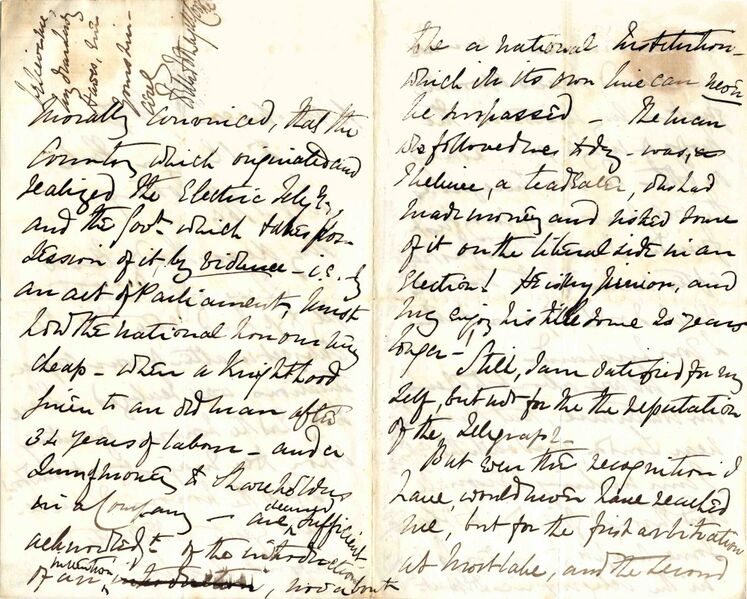File:CookeWmF11Nov1869rwLIPACKownerB.jpg

Original file (3,995 × 3,206 pixels, file size: 2.72 MB, MIME type: image/jpeg)
Side two of two-sided holograph letter dated 11 November 1869 written by William Fothergill Cooke to Sophia Macnamara Brunel Hawes, wife of Sir Benjamin Hawes, M.P., daughter of Marc Isambard Brunel and brother of Isambard Kingdom Brunel.
This letter pertains to Cooke's having just been received by the English Queen Victoria, at Windsor Castle, where he was bestowed the honor of Knighthood for his work on the electric telegraph with his partner and telegraph co-patentee Sir Charles Wheatstone, the latter who had been knighted the year before by Queen Victoria.
The letter is significant in that it shows the true side of Cooke and his true feelings and sentiments towards the honorable distinction he received from the Queen of England. Cooke's letter revealed here demonstrates that he held very bitter sentiments over the way his country of Great Britain regarded his work and contribution to the telegraph: sentiments that have not yet been disclosed in history by the world's historians to date.
Cooke, together with John Lewis Ricardo, founded the Electric Telegraph Company in 1846. Today known as British Telecom, the Electric Telegraph Company was the world's first public telegraph company.
In the letter to Mrs. Hawes, Cooke writes, in part:
"I have today had the honor of visiting upon her Majesty at Windsor! I feel the honour I have received quite adequate to my personal deserts - but I am morally convinced, that the country which originated and realized the Electric Telegraph, and the Gov't. which takes possession of it by violence - i.e. by an Act of Parliament, must hold the national honor very cheap - when a Knighthood given to an old man after 34 years of labour - and a sum of money to shareholders in a Company - are deemed sufficient acknowledgement of the introduction of an invention, now about to be a national Institution , which in its own line can never be surpassed."
Cooke also writes that this is his "first letter after receiving the honour which I owe to your Father and your husband." Mrs. Hawes' father Marc Isambard Brunel presided over the heated arbitration of 1840-1841 between Cooke and Wheatstone pertinent to equal acknowledgement over the invention for which Cooke felt he was not properly addressed publicly.
This letter is part of a cache of letters acquired by American historian Richard Warren Lipack and was used in his research of William Fothergill Cooke's only extant manuscript journal on his telegraph development, first discovered by him in America in the late 1990's.
Also known as Codex Lipack, the Cooke journal pertains to the development of the first perfected commercial electric telegraph installations and systems in the world and what can be defined as the genesis of the "world-wide web" or "Internet." The Codex Lipack represents the earliest extant document pertinent to the invention and evolution of modern electric communications on Earth.
File history
Click on a date/time to view the file as it appeared at that time.
| Date/Time | Thumbnail | Dimensions | User | Comment | |
|---|---|---|---|---|---|
| current | 03:24, 4 May 2022 |  | 3,995 × 3,206 (2.72 MB) | Richard Warren Lipack (talk | contribs) | |
| 07:21, 28 April 2014 |  | 747 × 599 (120 KB) | Richard Warren Lipack (talk | contribs) |
You cannot overwrite this file.
File usage
The following page uses this file: